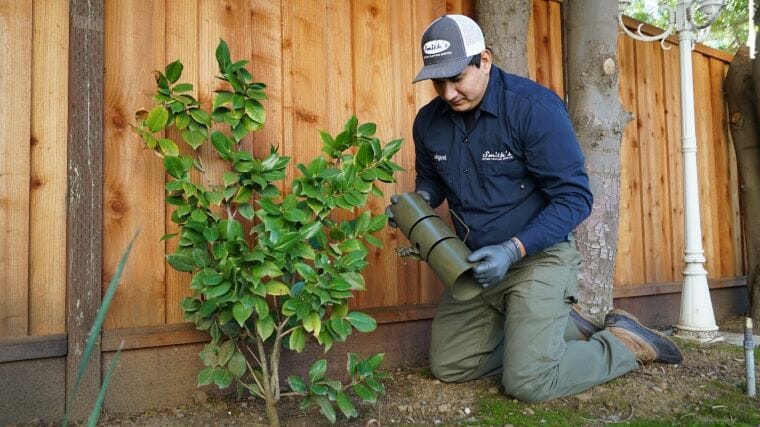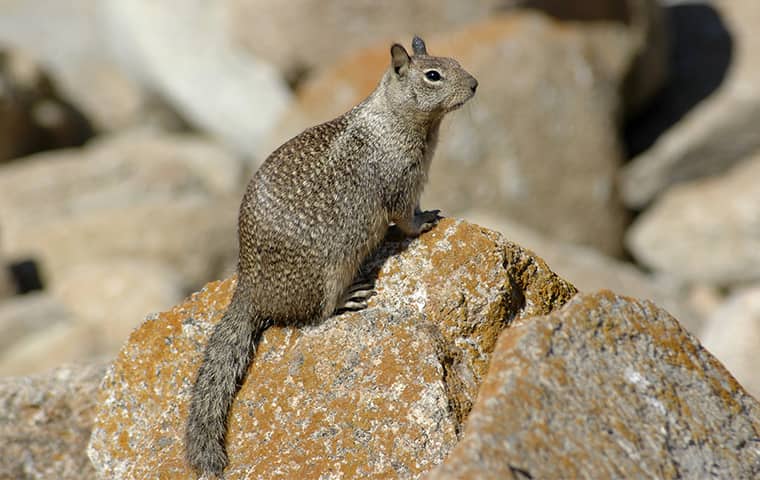Ground squirrels can quickly destroy gardens and yards, leaving behind unsightly burrows.
Here at Smith’s Pest Management, we help homeowners in California keep these pests away for good.
In this blog, we share our professional ground squirrel control tips so you can quickly reclaim your yard.
Key Takeaways
- To get rid of ground squirrels, you can use traps, baits, fumigation or more humane approaches such as pepper spray or castor oil, decoys, hazing, or live-catch traps.
- You should also address existing pest infestations and modify your yard and garden to make it less appealing to ground squirrels.
- Avoid unproven methods like gum, coffee grounds, barricades, repellent plants, or exhaust fumes, as they are ineffective and may worsen the problem.
Lethal Methods
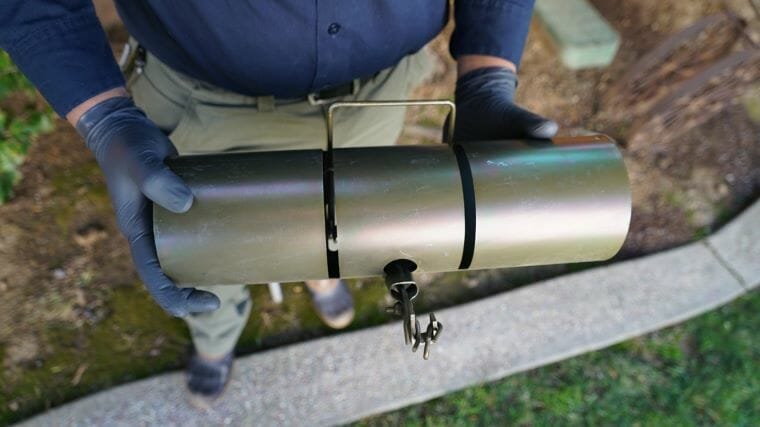
| Method | How it Works | Pros and Cons |
| Lethal Traps | Generally speaking, trapping is the recommended tactic for removing small ground squirrel infestations.
Snap traps, conibear traps, and live traps all work well, although snap traps should be covered with a box when used outdoors. This prevents non-target species from encountering the traps. They can also present a snap or injury risk for the person or people setting the trap. Related: How to Trap Ground Squirrels |
Pros: Effective, can get rid of small ground squirrels infestations quickly
Cons: Disposal of dead animals, may harm kids or pets, can trap non-target animals, unsightly |
| Baiting | For larger ground squirrel infestations, rodenticides) are the most effective, safe, and affordable control methods. It’s economical, long-lasting, and passive – meaning it works even when you’re not working.
Rodenticides approved for use in ground squirrel populations include grain baits made with zinc phosphide and anticoagulants such as diphacinone and chlorophacinone. Baiting with first-generation anticoagulant grain baits is most effective in the spring since ground squirrels are most active at that time. If you’re using anticoagulant bait, it’s critical to place it directly into a bait box, which keeps it away from non-target species. Alternately, place it directly into the squirrel’s burrow. |
Pros: Effective and affordable, effective for large populations, low risk for secondary effects on other wildlife or the environment, easy to deploy
Cons: Ground squirrels that consume first-generation anticoagulants may die inside double-wall construction or other inaccessible areas, creating odor problems and a possibility of further pest problems; a license and insurance are required to use baits |
| Fumigation | Fumigation is a common method to deal with ground squirrels.
Since fumigation is conducted underground, it’s safer for non-target species while also effectively eradicating ground squirrels. Like trapping and baiting, burrow fumigation is most effective in the early spring, when the soil moisture is high enough to contain the gas. Gas bombs (a popular type of fumigant) are designed to kill the pests quickly. Phosphide tablets are also popular options for “bombing” burrows. Keep in mind that gas bombs aren’t legal everywhere, so you’ll need to check your local laws and regulations before purchasing and administering gas bombs. |
Pros: Conducted below-ground, which makes it a safe yet effective method, kills ground squirrels quickly
Cons: Must be done at a specific time of the season, subject to strict rules and regulations |
Humane Methods
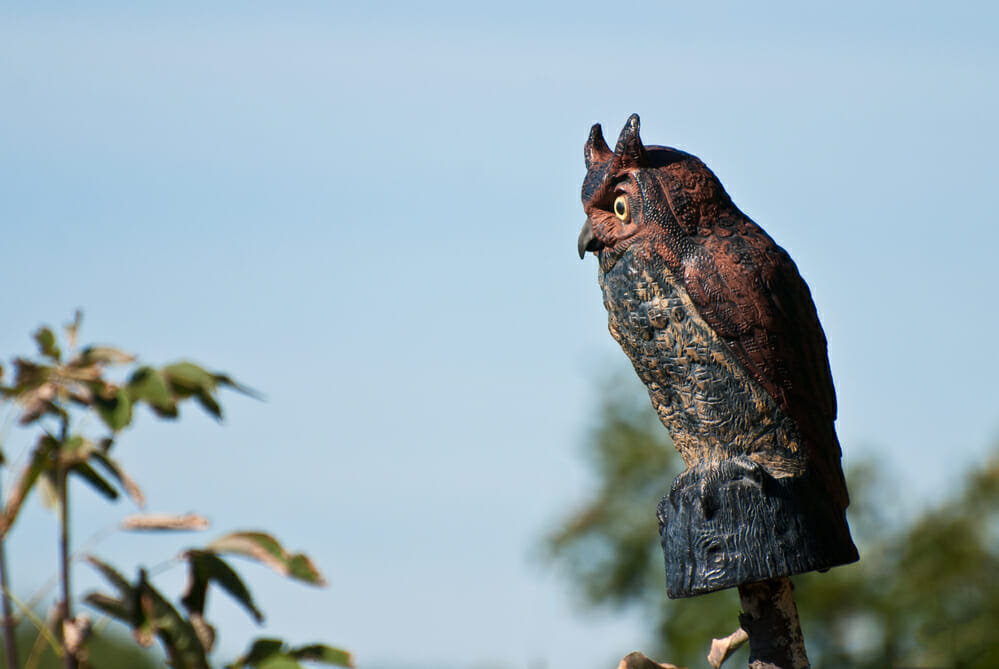
| Method | How it Works | Pros and Cons |
| Pepper spray | Soak a cup of plain red pepper flakes in a cup of hot water for 12 hours. Add a splash of dish liquid and another pint of water and strain the entire mixture into a spray bottle.
Spray plants and leaves the squirrels have been nibbling on, as well as visible burrows. The scent will deter the animals and make your yard less appealing. |
Pros: Affordable, easy, non-toxic
Cons: May be irritating for kids and pets; requires manual reapplication, repellents like pepper spray and castor oil can work if applied daily – in quantities great enough to saturate the soil – but the ground squirrels usually come back once the repellent wears off; repellents do not reduce ground squirrel populations; repellents can be extremely costly, time-consuming, and inefficient to apply; repellents do not reduce ground squirrel populations; repellents are only capable of providing control in the exact area you apply them |
| Castor oil | Castor oil is an affordable, accessible way to get rid of critters.
For best results, mix ¼ cup of castor oil with two tablespoons of dishwashing liquid. Mix two tablespoons of this mix into a gallon of water and spray it anywhere in your yard you have noticed ground squirrel activity. |
Pros: Humane, easy to make, affordable
Cons: Can affect other pets and animals, manually intensive; must be applied regularly for it to be effective; repellents do not reduce ground squirrel populations |
| Decoys | Ground squirrels have many natural predators, but you don’t have to introduce these predators to get rid of ground squirrels.
Instead, you can use decoys to scare the squirrels off. An owl decoy, for example, will frighten squirrels and make them less likely to call your property home. For best results, purchase at least 3-4 decoys and position them around your yard, anywhere you’ve noticed squirrel property. Move the decoys regularly to keep squirrels on their toes. |
Pros: Effective, affordable, easy to use, non-toxic, safe for kids pets, and other animals
Cons: Time-consuming; many people find decoys ugly, squirrels may “get used to” decoys and come back |
| Natural predators | Wondering how to keep squirrels away from the garden?
While it might seem strange to solve a rodent problem by introducing more animals, inviting predators to your yard can resolve your ground squirrel population. Plant tall trees to attract hawks and other raptors or use large rocks and brush cover piles to attract snakes that will eat the ground squirrels. |
Pros: Effective at reducing ground squirrel populations, long-term solution
Cons: Expensive, time-consuming, and labor-intensive to set up; many people do not feel comfortable attracting snakes and birds of prey to their yards, especially if they have young kids; will not eliminate infestation; must be combined with other methods such as trapping |
| Live-catch traps | Traps don’t have to be fatal for squirrels. Instead, try live capture traps, which contain squirrels without killing them.
While live-catch traps aren’t ideal for large ground squirrel populations, they can remove small infestations. Purchase these traps at your local home or hardware store. Bait your traps with pretzels, acorns, birdseed, or peanut butter and place them anywhere you’ve noticed squirrel activity. Once you capture a squirrel, treat it humanely until you can relocate it. We recommend placing a blanket or similar cover over the trap since this will keep the squirrel relatively calm until you can release it. Live-trapped squirrels can then be humanely euthanized, if legal in your area or relocated at least 5 miles from the trap site. Keep in mind that live-trapped squirrels will be stressed and may become aggressive. Never attempt to handle a live-trapped squirrel since they may bite or scratch you with their sharp teeth and powerful claws. Finally, remember that some states don’t allow the trapping of wild animals, so you’ll have to consult your local laws and regulations before taking this step. |
Pros: Effective, humane, removes squirrels from your property, captures only target pests
Cons: Requires you to handle squirrels manually, state law requires all squirrels to be euthanized on-site, must check traps frequently, can be time-consuming; costly (sometimes up to $100 per trap); since most populations are dozens or hundreds of animals, trapping may not be cost-efficient |
| Hazing | If you bother ground squirrels enough, they will stay away. You can do this by using motion-activated devices that blast artificial hawk, or predator sounds to scare ground squirrels.
Keep in mind that these methods only work if you’re very consistent with them. Ground squirrels will only stay away as long as you continue making the environment uncomfortable for them. |
Pros: Can be effective if you spend 5 to 7 days a week using them, humane, easy to install
Cons: The animals will only stay gone as long as you continue bothering them; may be unsightly; hands-on and othersome to pets, which may be able to hear the noise; impractical for many sites; costly, squirrels quickly become desensitized to scare tactics, hazing tactics may make an area unpleasant for humans to use or inhabit |
| Address other pest infestations | Ground squirrels love to eat insects, so dealing with any present insect infestations is one of the best ways to send ground squirrels packing.
Contact a professional pest management company like Smith’s to help you resolve insect infestations and reduce available food sources for ground squirrels. |
Pros: Effective, humane
Cons: This is a long-term solution but won’t remove ground squirrels immediately |
| Habitat modification | Managing ground squirrels can be difficult since the management actions needed to control them depend on the squirrels’ activity pattern, feeding preferences, and the time of year.
That said, habitat modification is one of the best management tactics for ground squirrels. Here are a few habitat modification tips:
|
Pros: Effective, humane, long-lasting
Cons: This is a labor-intensive process that won’t eliminate existing ground squirrel populations
|
Important Laws and Regulations

Although ground squirrels are not federally protected, the United States Fish and Wildlife Service (USFWS) enforces broader legislation, such as the Animal Welfare Act.
This Act establishes guidelines for humane treatment to ensure that animals are not subjected to unnecessary suffering.
In California, there are specific rules about controlling and trapping ground squirrels. The California Department of Fish and Wildlife (CDFW) handles these rules under the California Fish and Game Code.
According to the state, property owners and managers can kill ground squirrels if they damage crops or property, but they must use approved and humane methods.
For example, live traps and lethal methods like gas cartridges or anticoagulant bait must adhere to state guidelines and may require permits, especially on conservation lands or public spaces.
It’s also important to note that ground squirrel control in California has changed significantly since the passage of the California Ecosystems Protection Act of 2023, or Assembly Bill 1322.
This bill banned the use of certain rodenticides that contain Diphacinone and restricted the use of Rozol Ground Squirrel Bait.
Specifically, the bill requires a license for use and limits the application of this product to at least 50 feet away from any structure, making it impractical for use on most properties.
California has also passed legislation that limits the use of carbon monoxide to control ground squirrels and other burrowing pests (more on that here).
Since these changes were implemented, homeowners have been forced to find more sustainable and eco-friendly ways to manage ground squirrels, including trapping, exclusion, and habitat modification.
When to Call a Pest Control Professional
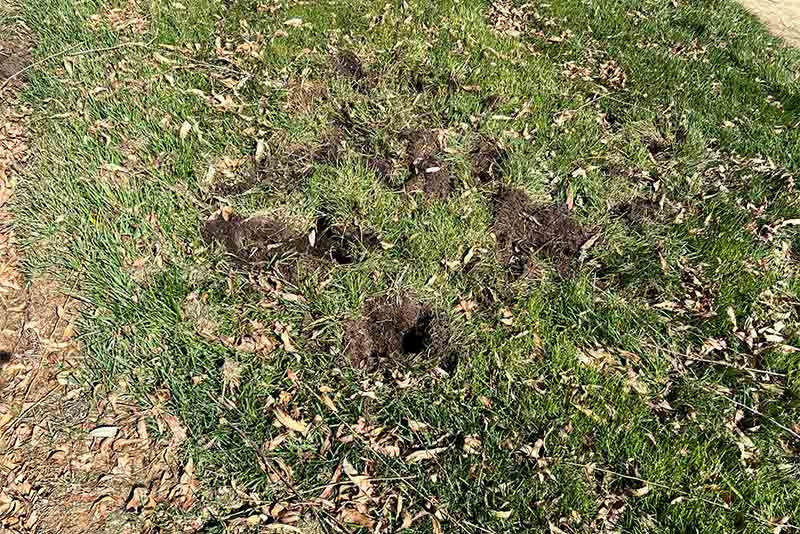
Generally, you should call a pest management professional for help whenever you’re facing a severe ground squirrel infestation.
Because ground squirrels are crafty, intelligent creatures, control programs vary significantly – depending on the species and the nature of the infestation.
Getting rid of large, well-established populations may require a multi-faceted approach that includes trapping, baiting, fumigation, habitat modification, and exclusion, which only a professional pest management team can deliver effectively.
Additionally, certain baits and fumigants are only approved for professional use, so homeowners won’t have access to them.
At the end of the day, hiring a pest management professional is the fastest and most effective way to get rid of ground squirrels on your property.
Here’s how our team at Smith’s Pest Management gets rid of ground squirrels professionally and humanely:
1. Inspection
The first step to remove ground squirrels is to locate their burrows. During this phase, our licensed pest control techs will visit your property, inspect your problem areas, and assess the extent of the damage.
2. Management Plan
Once we’ve completed our inspection, we’ll develop a plan to deal with the infestation. Smith’s uses Integrated Pest Management (IPM) techniques to provide a comprehensive solution without excess use of poison.
3. Elimination
Many of our customers come to us after DIY methods fail.
We want to rapidly get rid of your squirrel infestation, so we’ll deploy the best elimination tactic for your property and unique circumstances.
4. Ground Squirrel Exclusion
Smith’s Pest Management does not provide ground squirrel exclusion, although we will make recommendations if we believe exclusion is a good fit for your property.
Our goal is to make your property less attractive for ground squirrels but as relaxing and beautiful as possible for you.
“When we treat for ground squirrels, if we fumigate using smoke or carbon monoxide, we have to treat each of these because sometimes they’re patched up underground. If you use smoke and you blow smoke down these holes, you’ll see the smoke typically come out of the nearby holes but also you’ll see smoke come out somewhere even fifty feet away.” – Zachary Smith, owner of Smith’s Pest Management.
How to Keep Ground Squirrels Away
While the following won’t guarantee that you will never have ground squirrels take up residence on your property, they may help minimize their numbers and keep your property relatively safe from their destructive habits.
- Keep all trash in tied trash bags inside trash containers with locking lids to keep squirrels and other foraging animals out.
- If you have outdoor dining areas, make sure to thoroughly clean up after each gathering.
- If you have plants with nuts, berries, or vegetables, keep these areas as picked up as possible, reducing food sources for squirrels and other animals. We recommend raking the yard at least twice a week in the fall when leaves are falling. If you have garden beds, be sure to rake them regularly to pick up and remove any organic debris.
- Eliminate water sources on your property as much as possible.
- Keep your grass trimmed short and your yard uncluttered. This will reduce hiding places for California ground squirrels, which are preyed upon by red-tailed hawks, golden eagles, coyotes, foxes, badgers, weasels, house cats, dogs, and snakes.
- Reduce insects (that squirrels feed upon) on your property by partnering with a professional pest control company.
- Install tall fencing or netting around gardens or bushes you don’t want these animals getting into. Make sure the fencing goes at least a foot underground. Chicken wire is a great material to use since it prevents squirrels from squeezing through the fence.
- Use motion sensor water sprinklers to scare squirrels away with water.
- If you have bird feeders on your property, swap them out with squirrel-proof bird feeders with a cage that prevents squirrels from eating the birdseed, while allowing birds free access.
- Build chicken wire frames around your garden or flower beds. For best results, bury chicken mesh at least 4-6” deep around the garden beds or flowers, so ground squirrels can’t burrow under it.
- Spray a cayenne pepper solution around the foundation of your home and throughout your yard to keep ground squirrels away.
Are Ground Squirrels Taking Over Your San Francisco Bay Area Yard? We’re Here to Help!
Tolerating ground squirrels just isn’t an option. After all, the pests can cause thousands of dollars of damage to your property. Plus, they can carry fleas and diseases and attract unwelcome visitors like coyotes.
Fortunately, you don’t have to live with them forever. Our team is here to help.
Here at Smith’s Pest Management, we’re conscientious and concerned lovers of nature.
While we help homeowners and businesses send ground squirrels packing with the best ground squirrel control services in the Bay Area, we do so in the most humane and low-impact way available.
We use EPA-approved rodent control products, apply them in accordance with all label directions, and keep a close eye on developing science to ensure we’re never using products or techniques that could harm the environment, non-target species, or the ecosystem at large.
Let us eliminate your ground squirrel problem effectively, humanely, and in a way that’s safe for your kids and pets.
Our team helps residential and commercial customers in Northern California – from Marin to Monterey.
Contact us today for a free ground squirrel control quote: (408) 871-6988
FAQ
What is a ground squirrel?
California ground squirrels (Spermophilus beecheyi) are 9-11” long with a bushy tail that’s about as long as their body. Their fur is a mix of gray, light brown, and dusky fur, which gives them a mottled appearance.
Strips of darker fur extend from the head to the mid-back, while gray fur forms a cape over the sides of the head and shoulders. Their underside is a pale buff or grayish yellow.
There are about 62 species of ground squirrels in the world, but the thirteen-lined ground squirrel (Ictidomys tridecemlineatus) and the California ground squirrel (S. beecheyi), sometimes called gophers in the Midwest, are the most common pests in both rural and developed areas.
Ground squirrels are active from about late winter to early spring or mid-fall.
While they may hibernate in areas that get very cold during the winter, they are active all year round in temperate climates like California.
Ground squirrels mate in the spring and produce single litters that contain about 4-8 young each.
What attracts ground squirrels?
One of the best ways to deal with a ground squirrel infestation is to understand what’s drawing them to your property in the first place.
Here are a few of the biggest culprits:
1. Food and water
Ground squirrels are primarily herbivorous, and what they eat depends on the season. When they come out of hibernation, they’ll gravitate toward green grasses and herbaceous plants.
As the season progresses and annual plants begin to dry out and produce seeds, squirrels will start consuming more grains, nuts, and seeds.
They’ll also begin to search for and store a variety of foods, including the following:
- Fruit (especially gooseberries and prickly pear)
- Nuts like acorns and walnuts
- Green vegetation (including plant and flower buds)
- Roots
- Buds
- Grains like corn and wheat
- Frogs
- Garbage
- Human food leftovers
- Seeds
- Birdseed
- Insects
- Bird eggs (including chicken eggs)
- Fungi
Fish ponds, birdbaths, and streams also provide squirrels with food and water sources.
2. Shelter
Ground squirrels like to live in large, grassy areas that provide plenty of unimpeded space for their excavation. They prefer open, grassy areas with light, dry soil and plenty of available food nearby.
Where do ground squirrels live?
California ground squirrels live and breed in burrows containing 2-20 or more animals. They build their burrows into hillsides or low berms and tend to avoid flood-irrigated areas, dense woods, very moist soil, or lands that are frequently cultivated and tilled.
If they can’t find a hillside, ground squirrels will dig down vertically several feet to create a safe space. Their burrows are about 4-5” in diameter, 2.5-4’ below the surface of the ground and 5-35 feet in length.
Multiple generations of ground squirrels use each burrow, and individual squirrels all have their own entrances. Once they’ve built their burrows, ground squirrels stay close to them: both males and females can usually be found within 150 yards of their burrows.
What is the difference between a ground squirrel, a tree squirrel, and a chipmunk?
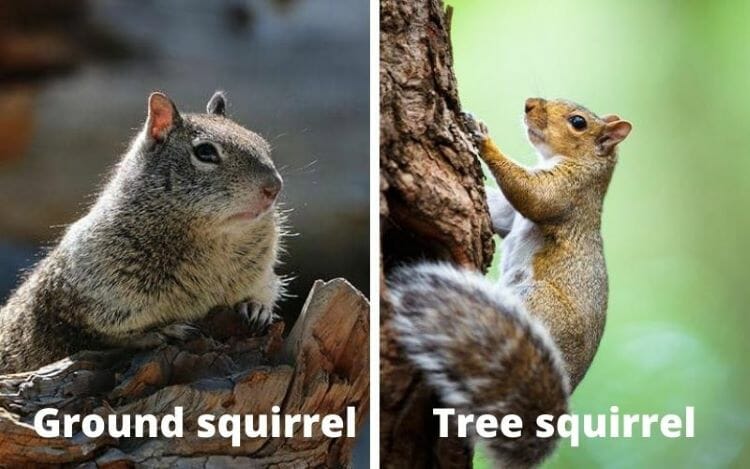
While tree squirrels tend not to cause much damage, their ground-dwelling counterparts can be a big problem.
In fact, the California ground squirrel is the most common vertebrate pest in agricultural areas and urban and suburban areas.
To understand the differences between these two squirrel species better, here’s a quick breakdown of their differences:
Ground squirrels burrow – tree squirrels do not.
Tree squirrels are not typically a problem unless they find their way inside attics or other places inside a home.
Once inside, they can cause issues because of their constant chewing. A squirrel in an attic can damage a home’s structure, destroy insulation, chew through wiring, or damage stored items.
California ground squirrels, however, cause enough damage without entering the home. Ground squirrels dig. It is what they do. They will dig burrows and tunnels in yards, orchards, around building foundations, patios, decks, and gardens.
And since these animals multiply quickly (each female has five to nine babies a season), infestations snowball.
Large infestations can generate large holes in the grass that present a danger to anyone walking or running there.
Ground squirrels cause damage to lawns, fields, and gardens.
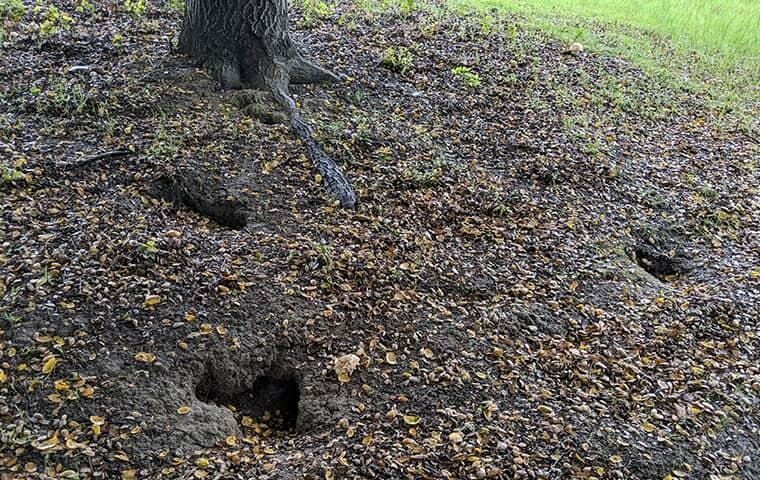
Ground squirrel burrow entrances are large enough to engulf a person’s foot, posing the risk of a broken ankle or leg.
On the other hand, tree squirrels live in tree cavities or nests, high up off the ground where nobody is at risk of tripping over their home.
Which ground squirrel control methods are ineffective?
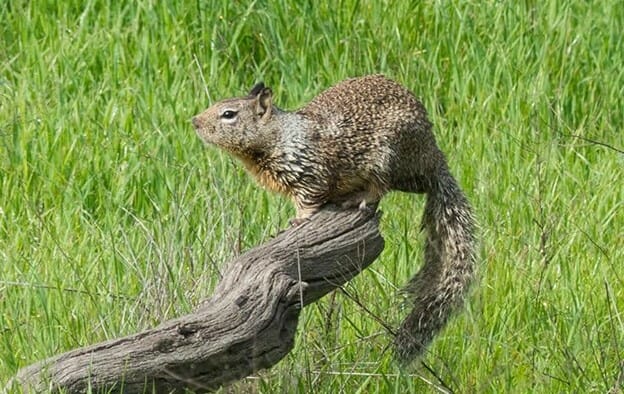
There’s no way around it: controlling burrowing rodents can be difficult.
Part of what makes the process so hard is that there are dozens of rodent control myths floating around out there, including the following:
1. Gum
Leaving gum out for ground squirrels to find will not work. While some people believe the gum will expand in their intestines and kill them, it has never been proven.
2. Coffee grounds
Spreading coffee grounds around the entrances to burrows will not deter ground squirrels and may be more work than it’s worth.
3. Screening and barricades
While these options may work in very localized areas, squirrels will readily dig a new burrow nearby. Unless screening can be extended throughout the property, barricades are not viable solutions to ground squirrel infestations.
4. Ground squirrel-repellent plants
Some people recommend planting barriers of ground-squirrel-repellent plants like narcissus, castor bean, or crown imperial plants. Unfortunately, that won’t work to keep these pests out of your yard. Ground squirrels are highly adaptive, and they’ll just figure out how to avoid certain areas or burrow up into them from underground.
People think they’ll shoot ground squirrels with a pellet gun or 22. Some think throwing repellent down their holes works. Others believe they can divert the exhaust pipe from their car into ground squirrel tunnels to get rid of the pests.
Unfortunately, none of these things work.
The fact is that ground squirrel populations can be so widespread that treating a few burrows with any given method won’t make a difference.
In fact, doing so will create a vacuum effect. You’ll create just enough vacant burrows that neighboring ground squirrel populations will move in and start reproducing, ultimately worsening your problem.
Here’s what we’ve found to be true in our field experience:
Anytime you’re dealing with widespread burrowing rodents like ground squirrels, you need to think about how you’re going to eliminate all of them within a football field radius of your property – about 100 yards in every direction.
If you can’t address the problem on that scale, you’ll just spend a lot of money and time on ineffective control methods that don’t work.
At Smith’s, we don’t want friends throwing good money after bad, so we’re here to tell you the truth: picking ground squirrels off one by one is not an adequate control method.
Instead, we recommend using a baiting program and putting out enough food (we’ve found 1/4 lb per animal to be a good starting point). Let that bait program run for an entire summer or two to control your ground squirrels.
If you’re going to try trapping ground squirrels, make sure you have a good euthanization program available. California law states that any ground squirrels you trap must either be euthanized humanely (drowning is not considered a humane option) or released in the same vicinity where you caught them.
So the myth-busting here is as follows:
Eliminate the population effectively and quickly, whether with bait or extensive trapping. Don’t be fooled by anyone who tells you that treating a few burrows is enough, and don’t waste your time relying solely on hazing, noisemakers, or repellents.
What's the difference between a ground squirrel vs. a chipmunk?
The ground squirrel and the chipmunk are very different animals. While both are small rodents, chipmunks have a distinct, reddish-brown fur with telltale stripes on their heads and bodies.
Like tree squirrels, chipmunks live in wooded areas and trees, while ground squirrels prefer to live, feed, and burrow in grassy areas like yards, pastures, and golf courses.
What diseases do ground squirrels carry?
Like most rodent pests, ground squirrels carry a host of dangerous diseases, including rabies, the bubonic plague, and leptospirosis.
Many of these diseases can spread to domestic animals or humans, so it’s wise to take steps to eliminate ground squirrels as soon as you notice an infestation.
What damage do ground squirrels cause?

1. Crop damage
Ground squirrels eat whole seedlings, nibble the tops of vegetables, and eat fruits and berries, thus destroying your vegetable garden.
Since ground squirrels can climb trees and vines to eat fruit and nuts, they can destroy grapes and other crops and eliminate harvests.
They also consume crops like alfalfa, lettuce, and berries and can girdle or kill trees by gnawing on bark and limbs or damaging a tree’s roots underground, which leaves the tree vulnerable to fungal infections.
2. Unsightly burrows
As ground squirrels dig their burrows, they excavate soil and rock to the surface and leave it in mounds near the entrances to their burrows.
Each year, they enlarge their burrow systems and the mounds associated with them, which can make harvesting crops mechanically or using small equipment (like lawnmowers) difficult.
3. Structural damage
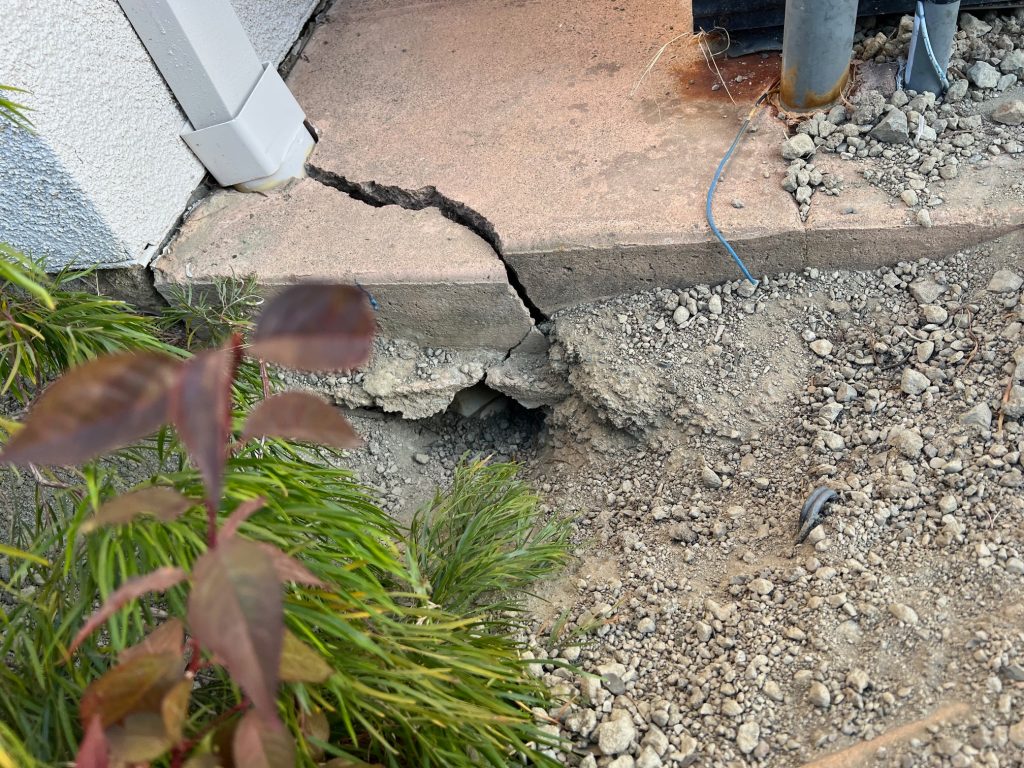
When ground squirrels excavate under buildings, it can cause foundation cracks and soil erosion that is hard to fix. Even worse, it may impact the stability of your structure.
Ground squirrel burrows have also been known to divert irrigation water and cause flooding or damage to water retention systems.
4. Lawn damage
Ground squirrels will gnaw the plastic heads of underground sprinklers, chew through sprinkler lines, and damage irrigation boxes. They will also create bald patches around your yard with their grazing.
“We’ve seen where high school sports have been canceled for the summer or for the year because coaches have deemed them unsafe. The other teams won’t play on their fields, so they have to forfeit games or travel and never have any home games just because a ground squirrel problem was never managed when it was just a couple animals.” – Zachary Smith, owner of Smith’s Pest Management.
5. Disease-risk
Ground squirrels can pose a risk to human health and safety since they carry and spread the sylvatic plague – a flea-borne disease that’s common in wild rodents.
To learn more about the types of damage ground squirrels can do, check out our article on the topic.
Can I kill ground squirrels?
The presence of ground squirrels can be so frustrating that you might just want to kill the pests. This is understandable, but it’s not always the best way. Shooting squirrels, for example, is a slow and expensive process.
How safe are anticoagulants for ground squirrel control?
Substances like Diphacinone and other first-generation anticoagulant rodenticides (FGARs) are known within the industry as multiple-feed toxins, which means that ground squirrels must consume the bait several times over multiple days to ingest a toxic dose.
Because of this multi-feed requirement, if a ground squirrel is captured by other wildlife, the amount of active ingredient in its body is very low at any given time. Multi-feed baits reduce secondary toxicity.
Additionally, FGARs have low primary toxicity concerns, which means that they’re safe for nontarget wildlife, even if nontarget species consume the bait directly.
To prove the safety of first-generation anticoagulants, the county of Contra Costa scattered these baits along a mile-long stretch of country road.
Then, they monitored for squirrel carcasses and found none (meaning the squirrels had died underground). They also monitored for secondary toxicity in wildlife and birds and found none.
What are signs of a ground squirrel infestation
How will you know if you have a ground squirrel infestation?
Look for the following signs:
- Holes. Ground squirrels create exposed, open tunnels with mounds of discarded dirt around the entrance. These holes tend to appear at the base of trees or around your garden plants.
- Destroyed plants or bulbs. If you notice that the tops of your vegetables are gone, or that the fruit has been harshly chewed off your plants, ground squirrels could be the culprit. They’ll also eat seedlings and certain ornamental plants and will dig up and eat flower bulbs.
- Patchy grass. Ground squirrels can cause serious damage to your yard and can easily cause bald areas with their grazing.
- Squirrel sightings. If you see ground squirrels or your domestic pets start bringing you dead squirrels, it’s a sure sign you have ground squirrels on the property. If you’ve seen one ground squirrel, you can bet it’s just one representative of a local population that numbers in the hundreds or thousands.
- Chew marks. Ground squirrels could be to blame if you’ve noticed gnaw or chew marks on your sprinkler heads, wood furniture, or anywhere else.
- Strange noises or smells. Have you noticed strange squeaking or scratching noises in your outdoor space? It could be ground squirrels moving around or digging burrows. You may also notice strange, musty smells, which could indicate the presence of ground squirrels and their feces and urine.
- Droppings. If you see ground squirrel droppings, which are solid, black or brown in color, tubular, and rounded in shape, it’s a sign that ground squirrels are frequenting your property.
- Missing chicken eggs. If you have backyard chickens and you’ve noticed missing eggs, it could mean that ground squirrels are stealing and eating them.
- Nests. Like tree squirrels, ground squirrels make nests. These nests are made of leaves, twigs, bark, moss, and other organic materials compressed into a dense bed.
Pro tip: Keep an eye out for subtle indentations or shadows on the ground, especially near trees. These seemingly insignificant marks could be entrances to ground squirrel burrows. These creatures often choose spots underneath trees for their homes, providing them with shelter and proximity to food.
Once you’ve identified a ground squirrel infestation, you need to move fast to put an end to it.

